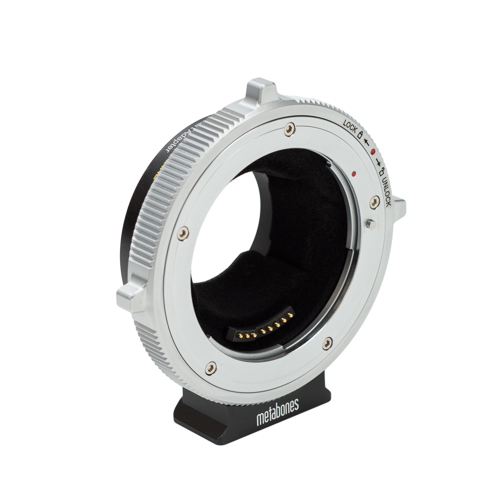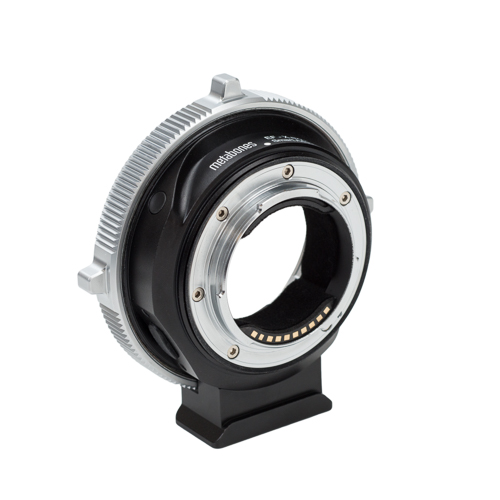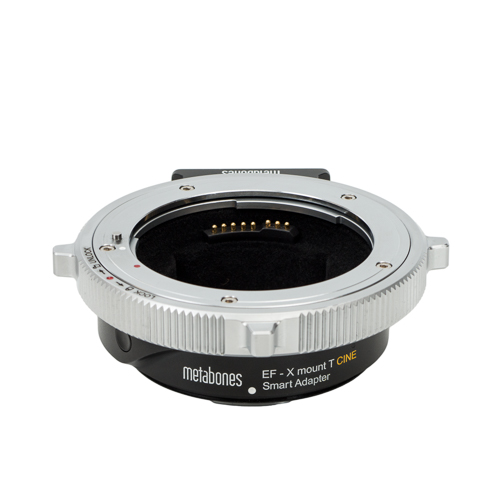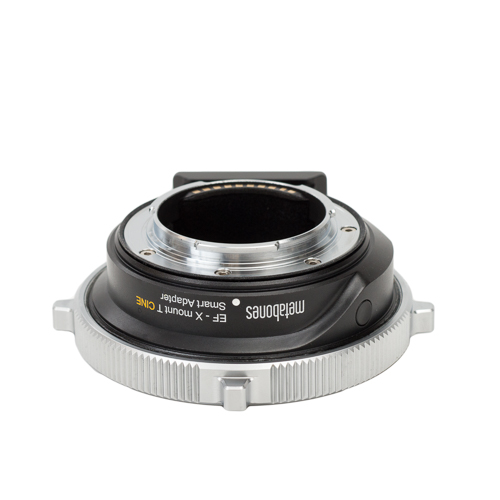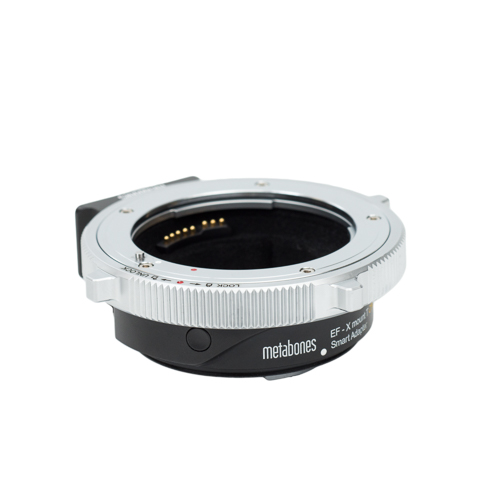Canon EF Lens to Fuji X mount T CINE Smart Adapter

Key Features

Electronic
- Canon EF mount lens to Fujifilm X-mount camera.
- Autofocus. Phase-detection autofocus (PDAF) is supported no matter which AF lens is used. Adapters support PDAF by translating pertinent metadata about the optics between the lens interfaces. In this way, broad support of the widest range of lenses is made possible.
- Lens iris/aperture is set by the controls on the camera body.
- Optical image stabilization (IS) lens support.
- Smooth iris support with the latest Canon (2009+), Tamron (SP series 2013+) and Sigma (2016+) lens models.
- Focal length and aperture are adjusted in EXIF (see note 3).
- Store EXIF data (lens name, focal length and maximum/minimum aperture) for one manual lens in the adapter.
- Parallax correction on the X-Pro series rangefinders is also supported.
- LED indicator shows communication status.
- Powered by camera body. With most lenses, no external power source required.
Mechanical
- Patented positive-lock EF lens mount.
- Flocking to reduce internal reflection.
- Rubber gasket protects the X-mount connection from dust and moisture.
- Aluminum alloy and brass construction with chromium plating.
- Satin surface finish.
- Detachable tripod foot compatible with Arca Swiss Style ball head, such as Markins and Photo Clam or attach to quick release plate by a 1/4"-20 screw.
|
Tested Cameras
|
- Fujifilm X-A1
- Fujifilm X-H1, X-H2, X-H2s
- Fujifilm X-Pro1, X-Pro2, X-Pro3
- Fujifilm X-T3, X-T4
- Fujifilm X-T30
- Fujifilm X-T100
|
|
Tested Lenses
|
| |
|
Smooth Iris |
| |
Model |
Support |
| |
Canon EF 40mm F/2.8 STM |
√ |
| |
Canon EF 50mm F/1.2L USM |
|
| |
Canon EF 50mm F/1.4 USM |
|
| |
Canon EF 50mm F/1.8 II |
|
| |
Canon EF 50mm F/1.8 STM |
√ |
| |
Canon EF 85mm F/1.2L II USM |
|
| |
Canon EF 100mm F/2.8 USM Macro |
|
| |
Canon EF 100mm F/2.8L IS USM Macro |
√ |
| |
Canon EF 135mm F/2 L USM |
|
| |
Canon EF 200mm F/2.8L II USM |
|
| |
Canon EF 300mm F/2.8L IS II USM |
√ |
| |
Canon EF 300mm F/4L IS USM |
|
| |
Canon EF 400mm F/5.6l |
|
| |
Canon EF 8-15mm F/4L Fisheye |
√ |
| |
Canon EF-S 10-18mm F/4.5-5.6 STM |
|
| |
Canon EF 16-35mm f/2.8L II USM |
√ |
| |
Canon EF 17-35mm F/2.8L USM |
|
| |
Canon EF-S 18-135mm F/3.5-5.6 STM |
|
| |
Canon EF-S 18-55mm F/3.5-5.6 II |
|
| |
Canon EF 24-70mm F/2.8L II USM |
√ |
| |
Canon EF 24-70mm F/2.8L USM Mk1 |
|
| |
Canon EF 24-105mm F/4L IS USM |
|
| |
Canon EF 28-70mm F/3.5-4.5 II |
|
| |
Canon EF 28-135mm F/3.5-5.6 IS USM |
|
| |
Canon EF 28-80mm F/3.5-5.6 III USM |
|
| |
Canon EF 70-200mm F/2.8L IS II USM |
√ |
| |
Canon EF 70-200mm F/4L IS II USM |
√ |
| |
Canon EF 70-200mm F/4L USM |
|
| |
Canon EF 70-300mm F/4-5.6 L IS USM |
|
| |
Canon EF 100-400mm F/4.5-5.6 L IS II USM |
|
| |
Canon EF TS-E 17mm f/4L |
|
| |
Canon EF TS-E 24mm f/3.5L II |
|
| |
Sigma 24mm F/2.8 Super Wide II |
|
| |
Sigma 30mm F/1.4 DC HSM Art 013 |
|
| |
Sigma 35mm F/1.4 DG Art 012 |
√ |
| |
Sigma 50mm F/1.4 DG HSM non art |
|
| |
Sigma 135mm F/1.8 DG HSM Art 017 |
√ |
| |
Sigma 18-35mm F/1.8 DC HSM Art 013 |
|
| |
Sigma 18-35mm T2 DC CINE |
|
| |
Sigma 18-125mm F/3.8-5.6 DC HSM |
|
| |
Sigma 24-35mm F/2 Art 015 |
|
| |
Sigma 24-105mm F/4 OS HSM Art 013 |
|
| |
Sigma 50-100mm F/1.8 DC HSM Art 016 |
|
| |
Tamron 45mm F/1.8 VC (F013) |
|
| |
Tamron 10-24mm F/3.5-4.5 VC HLD (B023) |
|
| |
Tamron 15-30mm F/2.8 VC (A012) |
|
| |
Tamron 17-50mm F/2.8 VC (B005) |
|
| |
Tamron 18-250mm F/3.5-6.3 Di II (A18) |
|
| |
Tamron 18-270mm F/3.5-6.3 Di II VC (B003) |
|
| |
Tamron 18-270mm F/3.5-6.3 Di II VC PZD (B008) |
|
| |
Tamron 24-70mm F/2.8 Di VC USD (A007) |
|
| |
Tamron 28-300mm F/3.5-6.3 XR Di (A06) |
|
| |
Tamron 35-150mm F/2.8-4 Di VC OSD (A043) |
|
| |
Tamron 70-210mm F/4 Di VC USD (A034) |
|
| |
Tamron 70-300mm F/4-5.6 Di VC USD (A005) |
|
| |
Tokina 50mm F/1.4 Opera |
|
| |
Tokina 11-16mm F/2.8 ATX PRO DX (II) |
|
| |
Zeiss ZE 18mm F/3.5mm Distagon |
|
| |
Canon EF-Extender (Teleconverter) |
|
|
|
Limitations
|
- Each lens needs to go through a calibration procedure <click to view> when first used. EF-X Mount Speed Booster ULTRA or EF-X Mount Smart Adapter will gather metadata by turning focus to infinity and minimum when the power is turned ON for the first time. If the lens has a focus limiter switch, set it to FULL prior to turning on the camera. Set camera to AF-S and use the autofocus a few times, although during the initial calibration stage the AF performance may be subpar and you may experience difficulty locking onto subjects. For a zoom lens, it is also necessary to zoom to both the wide end and the telephoto end of the zoom range. Turn off the camera to complete the calibration procedure. If calibration is successful the Speed Booster ULTRA or Smart Adapter will no longer turn focus to minimum the next time the camera starts up. If this calibration procedure is not completed properly, there may be problems such as excessive hunting, difficulty locking onto targets, inaccurate AF, incorrect parallax correction on X-Pro series and incorrect distance scale display on the camera (if enabled).
- Continuous autofocus (AF-C) and video autofocus may not work on some cameras such as X-T100. Increasing FOCUS SENSITIVITY and decreasing AF SPEED is required under the AF-C CUSTOM SETTING (MOVIE) menu.
- For video, aperture priority or manual exposure is recommended to avoid exposure flickering. Fujifilm cameras require fine aperture control but EF lenses are not capable of controlling the aperture with sufficient granularity.
- AF+MF and lens aberration correction are not supported.
- Some early film-era lenses have a large amount of backlash and may not be able to achieve the AF accuracy required for digital cameras. Old lenses with faulty sensors due to wear and tear may lead to AF problems on a mirrorless camera even though the lens may appear to function normally on a DSLR.
- Distance displayed by camera is approximate but may not match the lens' distance scale. Older optics which do not report distance information will display an incorrect distance on the camera.
- Parallax correction on X-Pro series is approximate and may not be accurate. Older optics which do not report distance information do not support parallax correction at all. All but the smallest EF lenses block a significant portion of the optical viewfinder.
- AF Range Limiter is supported only on newest Fujifilm cameras and require distance information support from the lens. If the option is greyed out try setting it in movie mode.
- Lens aberration correction is not supported.
- The adapter has no aperture ring. On a camera with no mode dial, configure the "APERTURE SETTING" menu option to "AUTO+MANUAL" and use the camera's front or rear dial to change aperture. The auto setting comes after the minimum aperture.
- Aperture diaphragm in Programmed and Shutter Priority exposure modes may make frequent noises with older lenses. In reality, all Fujifilm X-Mount lenses make frequent aperture diaphragm moves during use but native lenses and the latest adapted lenses taking advantage of Metabones' smooth iris feature can do so quietly without making noticeable tick noises.
IBIS is supported only with fixed focal length lenses at or below 100mm (after multiplying by 0.7x in the case of Speed Booster ULTRA). OIS will override IBIS. You cannot combine them. (fixed from firmware V1.10)- With IS/OS/VC lenses the IS MODE setting is ignored and both SHOOTING ONLY and CONTINUOUS modes behave in the same way which is similar to a Canon camera but different from what Fujifilm OIS lenses do. This is done to maximize IS effectiveness. A negative consequence of this is that there may be no OIS during focus check.
|
|
Unsupported List
|
- Lens correction such as peripheral shading, CA and distortion
- Focus confirmation "chip" (e.g. Dandelion)
|
Your PayPal receipt is your order confirmation. There is no separate email confirmation until the shipment takes place.
Disclaimer: we are NOT licensed, approved or endorsed by Canon and Fujifilm.
Description

Why Metabones®?
Since its inception, Metabones has been designing and manufacturing lens adapters recognized among professionals and enthusiasts as leaders in design and workmanship.
Contrary to the popular trend of other factories using an aluminum ring painted black on the camera-body-side, we instead take no short-cut but use precision-machined brass with chromium plating on both the camera-body and the lens sides of our adapters, in order to ensure smooth mounting, great appearance, and durability. The lens side of the adapter features a strong leaf-spring structure, strengthening the adapter-lens connection and ensuring tightness of the lens in order to reduce wear and prevent focus errors and optical alignment issues from appearing.
Metabones uses matte-black treatment to keep internal reflection to a minimum in order to maintain the maximum optical quality possible with the lens.
All Metabones Adapters follow this tradition of uncompromising precision, robust build quality and outstanding finish. Our new Smart AdapterTM series of products add industry-leading electronic interfacing technology from Canada, with true electronic control of the lens' aperture directly from the camera body.
Features
- Both camera-side and lens-side of the adapter are made of brass, precision-machined and plated with chromium.
- Satin surface finish - just like your OEM lens and camera mounts.
- Precise fit and solid connection - lens has no play, gap or wiggling when mounted on adapter and no adjustments are required to fit your lens.
- Designed to reach infinity focus while maintaining the correct registration distance required to maintain optical quality of CRC lenses or lenses with floating elements.
Our Smart AdapterTM series adapters have the following additional features
- True electronic integration of aperture diaphragm - let camera automatically choose aperture in P or S exposure modes, or dial in yourself on the camera body in A or M modes.
- EXIF data such as lens identification, focal length and aperture.

